|
|
|
Sort Order |
|
|
|
Items / Page
|
|
|
|
|
|
|
| Srl | Item |
| 1 |
ID:
124052
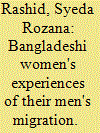

|
|
|
|
|
| Publication |
2013.
|
| Summary/Abstract |
This article examines Bangladeshi women's experiences of their men's migration. It focuses on the lifestyles, household responsibilities, and levels of compliance with or defiance against dominant gender ideologies concerning the everyday lives of left-behind women in two migration-intensive villages in Bangladesh. By locating the meanings and substance of women's power and agency in the context of their living arrangement in nuclear, joint, and natal families, I argue that the choices and priorities of these women be interpreted beyond liberal feminist models of "empowerment" and "emancipation."
|
|
|
|
|
|
|
|
|
|
|
|
|
|
|
|
| 2 |
ID:
133191
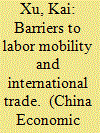

|
|
|
|
|
| Publication |
2014.
|
| Summary/Abstract |
This paper quantitatively evaluates the potential impacts of removing China's Hukou system on the world economy. By denying migrant workers the right to health benefits and housing, China's Household Registration (Hukou) system presents a significant distortion to the Chinese labor market that discourages the reallocation of its labor from agriculture to non-agriculture. I find that the elimination of Hukou could increase China's real income per capita by about 4.7%. Moreover, although for most countries the impact of removing Hukou is modest (less than 1% changes in real income per capita), substantial changes in real income could take place for China's small neighboring economies. For example, the decreases in real GDP per capita are 2.7%, 3.2%, and 4.1% for Bangladesh, Sri Lanka, and Vietnam, while Thailand stands to enjoy a 3.8% increase in its income.
|
|
|
|
|
|
|
|
|
|
|
|
|
|
|
|
| 3 |
ID:
183923


|
|
|
|
|
| Summary/Abstract |
This study uses ethnography along Ethiopian women's irregular migration routes through Djibouti to analyse the complex reasons women leave home to seek labour opportunities in the Gulf States. Theories and policies that either narrowly depict women's motivations as economic in nature or focus only on women's needs for security and protection, fail to account both for the politics of seeking employment abroad, and the ways migration provides women a potential refuge from various forms of violence at home. Using a feminist analysis, we argue that women do not migrate only for financial opportunities, but also to escape combinations of domestic, political and structural violence. As such, irregular migration both evinces a failure of asylum systems and humanitarian organisations to protect Ethiopians, and a failure of the state to provide Ethiopian women meaningful citizenship. Lacking both protection and meaningful citizenship, international migration represents women's journeys for opportunity and emancipation.
|
|
|
|
|
|
|
|
|
|
|
|
|
|
|
|
| 4 |
ID:
114776
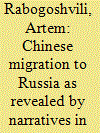

|
|
|
|
|
| Publication |
2012.
|
| Summary/Abstract |
This article provides an analysis of the electronic resources in the Chinese cyberspace devoted to the labor migration of Chinese people to Russia. In recent years, Russia has become an important destination country for Chinese labor migration, and migrating to Russia to work has been officially promoted as a potential means of poverty alleviation in northeast China. The author contrasts this state-regulated imagination - which in his understanding is based not least on the current Sino-Russian rapprochement - with more nuanced and competing constructions that are negotiated and circulated within the more informal and semi-anonymous virtual spaces of online bulletin board systems.
|
|
|
|
|
|
|
|
|
|
|
|
|
|
|
|
| 5 |
ID:
188578
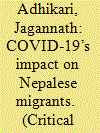

|
|
|
|
|
| Summary/Abstract |
This article examines how COVID-19 has impacted Nepalese migrants’ vulnerability and the actions they have taken to adapt to the situation. It investigates the problems created by COVID-19 from a disaster-risk management approach, the preparatory measures taken to deal with the disaster, and efforts by state and non-state actors in migrants’ rescue, relief, and reintegration into society. Marginal migrants, including unskilled workers, women, undocumented individuals, have been most affected by the pandemic, something which was also overlooked by government policies. The study shows that because government subsidies for migrants were too meagre and came too late, migrants have started going back abroad, despite COVID-19 risks. Furthermore, the study reveals that Nepalese migrants’ vulnerability depends on their levels of education, skills, gender, and legal status. In the light of these findings, the Nepal government needs a stronger institutional structure to help migrants navigate transnational spaces.
|
|
|
|
|
|
|
|
|
|
|
|
|
|
|
|
| 6 |
ID:
089550


|
|
|
|
|
| Publication |
2009.
|
| Summary/Abstract |
In this paper we fit stochastic frontier production functions to data of Chinese farms grouped into each of four regions-North, Northeast, East, and Southwest-over 1995-1999. These frontier production functions are shown to have statistically different structures, and the elasticities provide some evidence of diminished marginal products of chemical inputs in the East and capital services in the North and Southwest. Labor has a low elasticity except in the North. Standardized technical efficiency scores are estimated for the farms and are shown to have the same structure across regions and to be related to the age of the household head, land fragmentation, and the village migration ratio, controlling for year effects and village or regional fixed effects.
|
|
|
|
|
|
|
|
|
|
|
|
|
|
|
|
| 7 |
ID:
098430
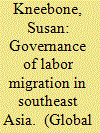

|
|
|
|
|
| Publication |
2010.
|
| Summary/Abstract |
This article examines the international governance framework for labor migration and evaluates the roles of international organizations, and regional strategies, for cooperation on governance of labor migration in Southeast Asia. It focuses on the mandates and strategies used by the two key international institutions in the region, the International Labour Organization and the International Organization for Migration, which have diverse origins and ideologies. The article considers the questions: Which institution is best suited to be lead agency in the region? How can the overlap between them be coordinated? Further, as a matter of law and policy, and in light of overlapping mandates and interests, how should international dialogue around migration issues be structured in the region?
|
|
|
|
|
|
|
|
|
|
|
|
|
|
|
|
| 8 |
ID:
140255
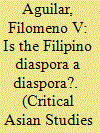

|
|
|
|
|
| Summary/Abstract |
Despite the widespread popularity of the discourse on diasporas since the 1980s, the recognition of a Filipino diaspora in the wider Anglophone scholarly world did not occur until the mid 2000s. A major factor for this recognition was the considerable number of scholarly works on Filipino Americans produced largely by Filipino American scholars who used diaspora as theoretical frame starting in the late 1990s. Grappling with the realities of the global migrations of Filipinos, the Philippine state and Filipinos in the Philippines and in other parts of the world also began to deploy the diaspora discourse. This article analyzes the ways in which the discursive fields in the US and in the Philippines have converged or diverged. Although diaspora can be a problematic concept, the author examines methodological issues that focus not so much on identities but on the imagined and constructed collectivity within which the putative diasporan identity of Filipinos is embedded. Without reducing diaspora to a reifying checklist, the author explores the Filipino diaspora discourse along these five dimensions: (a) population dispersal from an original homeland, real or imagined; (b) a process of diasporization; (c) ongoing relationship with the homeland, nurtured by collective memory or mythology; (d) idealization of return to the homeland; and (e) self-awareness or collective consciousness that is intergenerational and interrelated to coethnics and compatriots within the diaspora.
|
|
|
|
|
|
|
|
|
|
|
|
|
|
|
|
| 9 |
ID:
075835
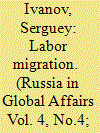

|
|
|
| 10 |
ID:
186696
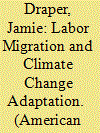

|
|
|
|
|
| Summary/Abstract |
Social scientific evidence suggests that labor migration can increase resilience to climate change. For that reason, some have recently advocated using labor migration policy as a tool for climate adaptation. This paper engages with the normative question of whether, and under what conditions, states may permissibly use labor migration policy as a tool for climate adaptation. I argue that states may use labor migration policy as a tool for climate adaptation and may even have a duty to do so, subject to two moral constraints. First, states must also provide acceptable alternative options for adaptation so that the vulnerable are not forced to sacrifice their morally important interests in being able to remain where they are. Second, states may not impose restrictive terms on labor migrants to make accepting greater numbers less costly for themselves because doing so unfairly shifts the costs of adaptation onto the most vulnerable.
|
|
|
|
|
|
|
|
|
|
|
|
|
|
|
|
| 11 |
ID:
127443
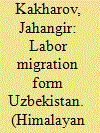

|
|
|
| 12 |
ID:
178036


|
|
|
|
|
| Summary/Abstract |
Although mountainous regions remained relatively isolated and almost untouched by the Ottoman rule, labor migration connected the inhabitants of these regions to the socioeconomic and political processes in the Ottoman Empire and beyond. Kruševo, a highland village located in present-day North Macedonia, provides an excellent case for understanding these connections. This paper presents systematic evidence from the Ottoman archives to document and analyze the social, economic, and demographic impacts of labor migration during this period. It provides an in-depth analysis of the Ottoman population and tax records of Kruševo in the 1840s, demonstrating the occupational profiles, migration patterns, and family and neighborhood networks of village residents during this period. Based on this analysis, it argues that labor migration was key to the transformation of social, economic, and demographic relations in rural communities and to the integration of even the most remote highland villages with the modernization processes that characterized the Ottoman Empire in the 19th century.
|
|
|
|
|
|
|
|
|
|
|
|
|
|
|
|
| 13 |
ID:
089981
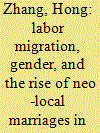

|
|
|
|
|
| Publication |
2009.
|
| Summary/Abstract |
In the past two decades, migration has become a quintessential feature defining the identity and life experiences of millions of young rural women who have left their home villages and migrated to urban areas for wage labor in China. However, due to the combined effects of the state-instituted hukou system and women's traditional gender roles of childcare and household duties, many female migrants face difficult choices when it is time for them to get married. In this study I examine the rise of a new marriage form among migrant couples in Dongguan, a newly industrializing boomtown in the Pearl River Delta of Guangdong province. I call this marriage a neo-local marriage as migrant couples set up their post-marital residence in a destination locale that is thousands of miles away from their hometowns. I first describe some of the new features of neo-local marriages for young migrant couples in Dongguan. I then explore Dongguan's boomtown status in the new economy, the changing labor market, and young migrants' agency as new forces behind the rise of this new marriage form. Finally I discuss both the potential transformative power of a neo-local marriage for young female migrants and the risks and constraints of this marriage for them as well.
|
|
|
|
|
|
|
|
|
|
|
|
|
|
|
|
| 14 |
ID:
163328
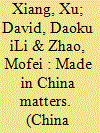

|
|
|
|
|
| Summary/Abstract |
We show that the integration of Chinese labor into the global labor market has played a key role in the global labor share decline since the late 1970s. Several key institutional changes, including the “reform and opening-up” that began in the late 1970s and China's entry into the WTO in 2001, accelerated this process. We build a two-country dual economic model to explain how labor shares decline in labor-intensive and capital-intensive countries simultaneously. Our empirical results show that the integration of Chinese labor significantly affects the global labor share, mainly through the channel of international trade and especially processing trade business.
|
|
|
|
|
|
|
|
|
|
|
|
|
|
|
|
| 15 |
ID:
175980


|
|
|
|
|
| Summary/Abstract |
The six Arab monarchies of the Persian Gulf host some of the largest global populations of international labor migrants. As COVID-19 began spreading across the Gulf, migrants made up a large share of the positive cases identified. Migrants’ living and working conditions in the Gulf and other structural vulnerabilities increased their exposure to the disease. Despite the risks of staying in the Gulf, many lower-income migrants preferred to do rather than returning to their home countries. For them, travel restrictions and the difficulty of finding work back home in the midst of the pandemic have outweighed the immediate danger of infection and illness.
|
|
|
|
|
|
|
|
|
|
|
|
|
|
|
|
| 16 |
ID:
170104
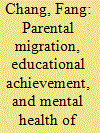

|
|
|
|
|
| Summary/Abstract |
China's rapid development has led to an unprecedented increase in migration rates as an ever-growing number of rural residents migrate to urban areas to seek better job opportunities and help alleviate family poverty. Economic pressures and structural restrictions force many of these migrant workers to leave their children behind in their rural homes, which has led to the emergence and expansion of a new subpopulation in China: left-behind children (LBCs). This study examines the impacts of parental migration on the educational outcomes (specifically math achievement) and mental health (specifically anxiety) of LBCs using data covering 7495 children in a prefecture of Shaanxi Province (from three surveys conducted between 2012 and 2014). We distinguish between “both parents migrating,” “one parent migrating,” “only a father migrating,” and “only a mother migrating.” We also explore the impacts on male versus female LBCs. We find no significant impact of parental migration on the math achievement of LBCs. In terms of mental health, however, our results indicate that left-behind girls were negatively affected by one parent migrating, especially if the migrating parent was the father. The findings suggest that it may not be necessary for policy makers to design special programs to improve educational outcomes of LBCs in general. However, local committees, schools, and parents should pay particular attention to left-behind girls living with only one parent, as they may be more vulnerable to mental health problems than their peers.
|
|
|
|
|
|
|
|
|
|
|
|
|
|
|
|
| 17 |
ID:
186734
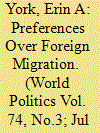

|
|
|
|
|
| Summary/Abstract |
Do existing theories regarding the impact of foreign migration explain preferences in non-OECD countries? The author adapts and applies explanations for opposition to migration in the Arabian Gulf, a significant region in global migration today, using a survey experiment implemented in Qatar. The results offer a rare validation of predictions from the labor market competition model, demonstrating that individual employment circumstances are important preference determinants. Additionally, while OECD citizens prefer high-skilled migrants, Qataris are indifferent about blue- versus white-collar workers. Mediation analysis suggests that this null effect is the result of competing cultural and economic concerns over the effect of differing classes of migrants on economic and social welfare. The novel context provides a critical test case of the labor market hypothesis and offers insight into how migration preferences in the Global South differ from the Western experience.
|
|
|
|
|
|
|
|
|
|
|
|
|
|
|
|
| 18 |
ID:
147420
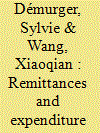

|
|
|
|
|
| Summary/Abstract |
This paper investigates how private transfers from internal migration in China affect the expenditure behavior of families left behind in rural areas. Using data from the Rural–Urban Migration in China (RUMiC) survey, we assess the impact of remittances sent to rural households on consumption-type and investment-type expenditures. We apply propensity score matching to account for the selection of households into receiving remittances, and estimate average treatment effects on the treated. We find that remittances supplement income in rural China and lead to increased consumption rather than increased investment. Moreover, we find evidence of a strong negative impact on education expenditures, which could be detrimental to sustaining investment in human capital in poor rural areas in China.
|
|
|
|
|
|
|
|
|
|
|
|
|
|
|
|
| 19 |
ID:
090109
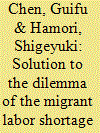

|
|
|
|
|
| Publication |
2009.
|
| Summary/Abstract |
Since 2003, China's labor market has been facing two coexisting crises: a rural labor surplus and a severe shortage of migrant labor. Using data from the 2000 China Health and Nutrition Survey questionnaire, which covers 288 villages in 36 counties, this paper attempts to find a solution to this dilemma. Specifically, a multinomial logit model, a Mincer-type model and a probit model are applied to examine the effect of educational level on the employment choices for rural laborers, and on the wages and the employment status of migrants. Based on the results of our analysis, we propose the implementation of policy aimed at increasing the educational level of rural dwellers, in conjunction with other policies to eliminate all artificial barriers, to facilitate the migration of rural laborers.
|
|
|
|
|
|
|
|
|
|
|
|
|
|
|
|
| 20 |
ID:
109299


|
|
|
|
|
|
|
|